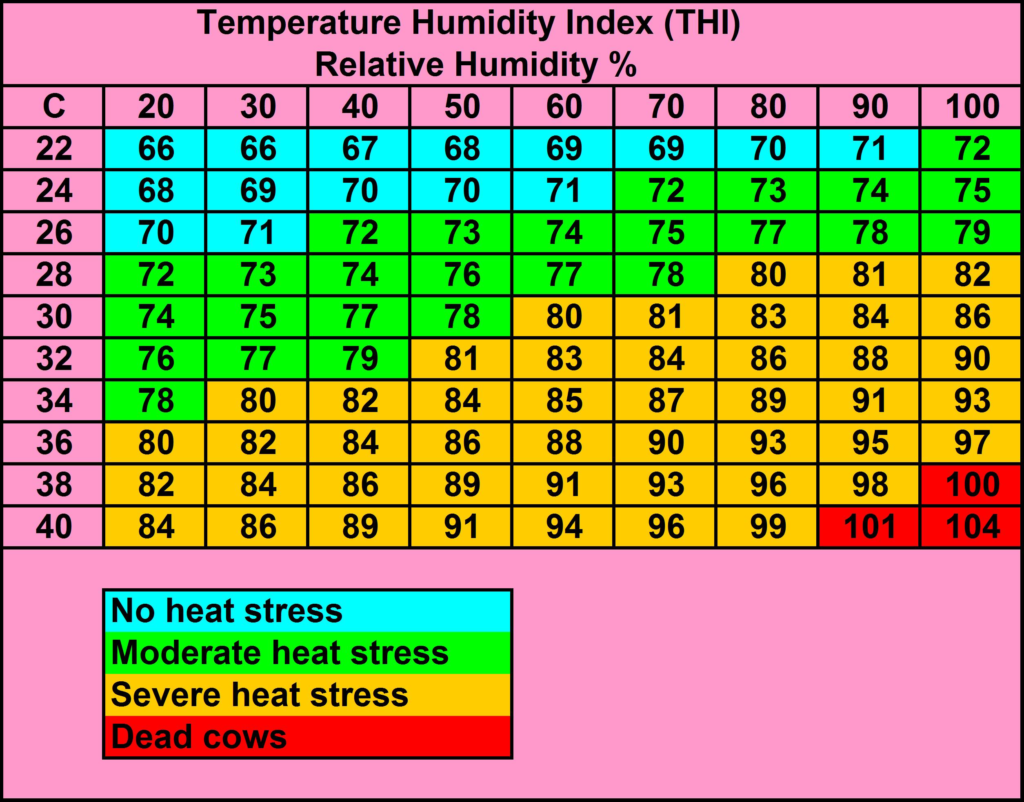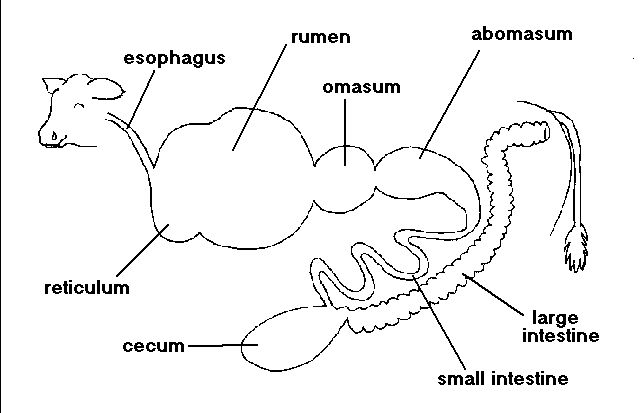The hot weather back in May 2020 and the high relative humidity seen from time to time since then has resulted in increased levels of heat stress.
Dairy cows are homoeothermic animals and need to maintain a constant body temperature of around 38.8°C +/- 0.5°C. They are sensitive to factors which influence their thermal exchange with the environment.
These factors include air temperature, radiant temperature, air velocity and relative humidity. Their internal temperature regulation is also affected by their state of equilibrium in the digestive tract. Acidosis has a major effect on temperature regulation.
A key symptom of acidosis is increased body temperature, increased body temperature is a symptom that for the most part goes un-noticed.
The recent weather temperature and humidity spikes have led to a re-focus on the use of rumen buffers to help regulate heat stress as well as acidosis.
For the most part both heat stress and acidosis are sub-clinical and un-seen but both conditions are serious enough to reduce production and fertility.
Heat stress costs you money.

Heat stress – the dairy cow
- Heat-stressed lactating cows have reduced dry matter intake, milk production and pregnancy rates.
- Heat stress also leads to increased lameness, disease incidence, days open and death rates.
- Heat-stressed late gestation cows have shorter gestation periods, calves with lower birth weights, reduced milk production and impaired immune function.
- Heifer calves from heat-stressed cows produce less milk for the first 30 weeks of lactation after freshening.
Heat stress – the calf
-
- At environmental temperatures above 25°C, the calf’s body temperature will rise
- In an attempt to keep cool, calves will : –
– Breath quicker
– Drink less milk and eat less feed
– Drink more water
– Spend longer standing and less time lying - Energy is diverted to maintain core body temperature, making less energy available for growth.
- Immune system is suppressed which reduces the calf’s ability to fight off disease.
Preventing Heat Stress
Many dairy farmers use many different approaches to help their cows regulate body temperature in hot, humid, and sunny weather.
Shade
Shade can help reduce the solar heat load and remains one of the first recommendations to help lactating cows and dry cows manage their body heat in hot weather.
Well ventilated housing and open sided shelter sheds are good options for providing shade. There are several shade structure options that can be used.
When providing shade, it is important to provide plenty of cover for all of the animals at the same time without crowding. Around 40 square feet per animal is recommended.
Ventilation
Air exchange
Housing ventilation cools cows by providing air flow exchange between inside and outside. Ventilation can be by either natural or mechanical means.
In hot weather, provide as much air flow as possible. The target air movement should be between 60 and 90 air exchanges per hour.
Tunnel ventilation brings air in at one end of a barn and exhausts it out the other.
-
-
- The size of fans and inlets should be correctly calculated and the fans should be well maintained and inlets opened to get the desired air velocity.
-
Cross ventilation brings air in on the side of the barn and exhausts it out the other side.
-
-
- Cross-vent housing can use a series of baffles to try to keep the air flowing and increase the total flow at cow level.
- It is important to size fans and inlets correctly. Make sure the fans are well maintained and inlets are open to get the desired air velocity.
-
Natural ventilation depends mainly on wind in hot weather.
-
-
- Open ridges will allow some hot air to escape out the ridge.
- Fresh air enters through the open sides of the barn.
-
Air speed
Increasing the air speed flowing past a cow can help her get rid of heat.
Tunnel ventilation, cross-ventilation with baffles and high-speed mixing fans are ways to increase the air speed past a cow.
Example of air speed impact
Research in America has shown that at a THI of 75 and an airspeed of three miles per hour (mph), a cow producing 45lires per day would be expected to have a respiration rate of around 68 bpm (mild heat stress). Increasing the airspeed past the cow to ten mph would lower her respiration rate to 57 bpm (no heat stress).
Mixing fans should be mounted above the cubicles and feed passages,
Mixing fans need to be mounted high enough to not be a hazard to people, cows or equipment moving underneath the fans.
-
-
- Point high-speed fans downward by 20 degrees so the air blows past the cows.
-
Cooling with water
Misters and sprinklers help cows get rid of body heat.
-
-
- Misting systems cool the air by evaporating water droplets using heat in the air.
- Sprinklers wet the cow’s skin, and her body heat is used to evaporate the liquid water on the skin.
-
Both methods will increase the air’s relative humidity, but if the barn has good ventilation, the humidity levels shouldn’t become excessive.
-
-
- Sprinklers and misters are more effective in drier weather with lower dew-point temperatures.
- Avoid constant spray, sprinklers need to cycle on and off to allow time for water evaporation.
- Avoid excessive sprinkling that causes water to run down and wet the udder because this can lead to an increased risk of mastitis.
- With high-pressure misters, the droplets need to evaporate before they hit the cubicles or bedding.
- Place misters near inlets to give a better dispersal to the cow waiting areas and feed barrier.
- Misters are not as effective when ventilation blows the mist out of the barn before the air cools.
-
Drinking Water
Hydration is incredibly important for a cow to regulate her body temperature, both during times of heat stress and cold stress. Adequate drinking water should be supplied at all times.
-
-
- In hot weather (32-35 degrees C for a high daytime temp), a lactating cow producing 36-45 litres of milk drinks 95-135 litres of water per day.
- The recommended amount of space is two linear inches of water space per cow. Consider increasing water space during hot weather.
- Water troughs should be at least three inches deep to allow cows to submerge their muzzle when drinking.
- Cows consume up to 50% of their daily water intake following milking.
- Make sure water flow to the trough and water capacity is adequate to account for large quantities needed at all at once.
-
Holding area cooling
Milking parlour holding areas need special attention paid to ventilation and cooling in warm weather to avoid heat stress.
Cows can be crowded in the holding area for up to an hour. A crowded pen reduces the airflow around a cow and can make it more difficult for her to avoid heat stress.
Reference table for heat stress evaluation

Rumen Buffers
Not all rumen buffers are the same so what do you need to know to make the right choice?
Most farmers are aware of the need to maintain a fairly neutral rumen Ph in order to allow the rumen microflora to flourish. The reason for this is that it is primarily to maximise the output of rumen bugs that in turn feed the cow or sheep and underpins their nutrition.
Most of the time the animal can regulate the rumen Ph itself.
Factors that can contribute to rumen acidosis problems are:
-
-
- Decreased DM intake with lower proportion of forage and higher levels of fermentable carbohydrates.
- Decreased rumination.
- Decreased saliva to the gut, a source of bicarbonate, with a reduction of its buffering power due to increased CO2 expelled (panting).
- The decreased rumen pH impairs fibres digestion efficiency: rumen fibrolytic bacteria are the most affected when rumen pH drops (below 6.0).
- Poor mixing of feed, allowing cows to selectively eat.
-
Rapidly fermenting high “D” value feeds tend to result in a production of acid as a by-product of their fermentation by the multiplying rumen bugs.The animal regulates this by cudding which produces saliva containing sodium bicarbonate which in turn increases the rumen Ph. An adult dairy cow can produce around 3.5 Kg of Sodium Bicarbonate a day by cudding!
However, the more we need to feed concentrates and fermentable carbohydrates, the more acid gets produced. This can make it just about impossible for the cow to buffer its rumen by cudding. The answer is to feed a buffer to help the cow regulate the Ph back to neutral say 6.7.
In fact, the caecum is responsible for around 15 to 20% of fermentation (anaerobic) and this is a valuable area for the breakdown of starches.
When the acid loading gets too high, we see a reduction in performance because intakes drop whilst the animal cuds until the rumen Ph returns to normal. If this is not possible, we start to see signs of clinical acidosis.
The Digestive Tract

So, what are the choices?
-
-
- Feed less concentrates. – Not much good if you are feeding for high output.
- Feed some extra fibre. – This works to a point but has limitations.
- Feed Sodium Bicarbonate. – Yes but it is short acting and you need lots of it 200g!
- Feed a complex buffer. – Yes but do you want long acting or short-term buffers?
- Feed a complete buffer. – This will buffer the rumen as well as the hind gut.
- Feed live yeast. – F 1 Yeast is proven to aid recovery of rumen Ph.
-
Acidosis Summary
Rumen acidosis is a metabolic disease of cattle. Like most metabolic diseases it is important to remember that for every cow that shows clinical signs, there will be several more which are affected sub-clinically.
Acidosis is said to occur when the Ph of the rumen falls to less than 5.5 (normal is 6.5 to 7.0). In many cases the Ph can fall even lower. The fall in Ph has two effects. Firstly, the rumen stops moving, becoming atonic. This depresses appetite and production.
Secondly, the change in acidity disrupts the rumen flora populations with acid-producing bacteria taking over. They produce more acid, making the acidosis worse. The increased acid is then absorbed through the rumen wall, causing metabolic acidosis, which in severe cases can lead to shock and death.
Cause
The primary cause of acidosis is feeding a high level of rapidly digestible carbohydrate, such as barley and other cereals. Acute acidosis, often resulting in death. It is most commonly seen in ‘barley beef’ animals where cattle have obtained access to excess feed. In dairy cattle, a milder form, sub-acute acidosis, is typically a result of feeding increased concentrates compared to forage made even worse if the silage is wet and acidic with a low Ph.
Symptoms
Acute acidosis often results in death, although illness and liver abscesses may be seen before-hand. Cattle may become depressed, go off feed, have an elevated heart rate or diarrhea.
Sub-acute:
-
-
- Reduced feed intake and lethargy.
- Poor body condition and weight loss.
- Unexplained diarrhoea.
- Increased body temperature, (contributing to heat stress).
- Pulse rate and respiratory rate may rise.
-
Buffer Choices
-
-
- Sodium Bicarbonate – Short acting TMR or ad-lib rumen buffer
- PhUK – Complex medium acting TMR low cost rumen buffer
- Equaliser Cool Cow – Complete long acting TMR rumen and hind gut buffer
- Acidbuf – Complex long acting TMR rumen buffer
- Vitalbuf – Complete long acting TMR rumen and hind gut buffer
- Live Yeast – F 1 Yeast shown to increase Rumen Ph by @ 0.2
-
JJT 07-2020
